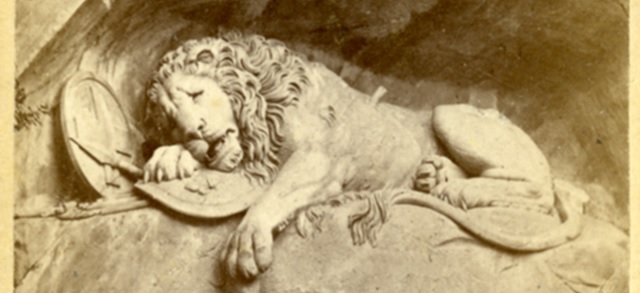
Monuments Class Projects
Architect/Sculptor of Monument
Thomas Ball (1819-1911)
Preview

Medium
photograph, carte-de-viste
Keywords
Emancipation Memorial, Freedman's Memorial, Thomas Ball, Moses Kimball, Abraham Lincoln, Archer Alexander, Boston, Massachusetts, Removed Monuments, Emancipation Proclamation, 13th Amendment, Bronze Group
Physical Dimensions
4 1/8 x 2 3/8 "
Date of Publication
c. 1880
Name of Monument
Emancipation Memorial
Date of Creation of Monument
1879
Date of Completion or Dedication of Monument
1879
City of Monument
Boston
Location within City
Lincoln Square, Park Plaza
State/Province of Monument
Massachusetts
Country of Monument
United States of America
Description
Why would a statue in Boston that honored one of the most important events in US history get removed? Although it was put up in good faith, it depicted the enslaved man as a common stereotype. Lincoln is shown as a tall, standing, white man who freed and saved the crouching and shirtless enslaved black man. This was a common theme. White men tended to be depicted standing or riding a horse above their minority counterparts, who were shown seated, crouched, or in a subservient position.
School of Art/Architecture
Neoclassical
Publisher
Photographic Studio of R. E. Lord, (Formerly Shaw & Lord)
File Format
image/jpeg



Comments
Joshua Walsh
2/20/2025
HIST 2011
CDV Background
The Emancipation Memorial, also known as the Freedman’s Memorial, commemorates and honors President Abraham Lincoln's ending of slavery. Abraham Lincoln (1809-1865) was the 16th US President (1861-1865) and served as president during the Civil War. He is credited with freeing the slaves with his Emancipation Proclamation and the passage of the 13th Amendment, as well as winning the Civil War and reuniting a broken nation.
In 1879, the Emancipation Memorial was erected in Park Square, Boston, Massachusetts. The monument is a bronze recasting of the Freedmen’s Memorial (1876) by sculptor Thomas Ball (1819-1911) in Lincoln Park, Washington, D.C. Ball was a famed sculptor of political and historical figures who used the neoclassic style for his sculptures. He is best known for the equestrian George Washington Statue in the Boston Public Garden. Moses Kimball (1809-1895) donated the recasted emancipation statue to the city of Boston.
The statue depicts President Abraham Lincoln holding his left hand above and symbolically freeing the enslaved man from his shackles. His right hand rests on a monolith and holds a scroll representing the Emancipation Proclamation. The freedman is modeled on Archer Alexander (1816-1880), the last enslaved man taken to Missouri under the Fugitive Slave Act. Alexander is depicted shirtless and crouching with shackles on his wrists, but in a position that suggests he is rising from this crouched position. On the base of the statue, the words “EMANCIPATION” are written in raised letters. An octagonal die raises the statue up above a bronze railing that sits around the two-and-a-half-foot base with urns at the corners. On the front of the railing base, raised letters read “A RACE SET FREE. AND A COUNTRY AT PEACE. LINCOLN RESTS FROM HIS LABOR.”
The dedication ceremony of Ball’s original statue in Washington was attended by several important figures of the time, including President Ulysses S. Grant and Frederick Douglass, who voiced his concerns about the depiction of the enslaved man. Douglass pointed out that the enslaved man was on his knees, and that while the statue showcased the efforts of the white man, it avoided the struggle of the enslaved men to free themselves. Those concerns fell on deaf ears until recently. In 2020, the people of Boston gained enough petition signatures to get the statue removed. The statue was removed that year, leaving just the platform. Surprisingly, even donor Moses Kimball had issues with Ball’s original statue. When it was recast for Boston, Kimball made sure that the enslaved man looked less passive, as if he were breaking his own shackles. They did this by changing his passive expression and showing his muscles straining. Even so, these small changes were not enough to save this statue from its recent removal.
Bibliography
Browne, P. (2020, July 9). Boston’s misguided emancipation monument. Historical Digression. https://historicaldigression.com/2017/10/20/bostons-misguided-emancipation-monument/
City of Boston. (2021, February 26). Emancipation group. Boston.gov. https://www.boston.gov/departments/arts-and-culture/emancipation-group
Crampton, S. (2025, January 21). Reckoning with Boston’s emancipation monument. Historic New England. https://www.historicnewengland.org/reckoning-with-bostons-emancipation-monument/
Jones, D. B. (2023, June 19). Emancipation memorial, a war memorial. , a War Memorial. https://www.hmdb.org/m.asp?m=215824
Kimball, M. (1879, December 6). Bronze group commemorating emancipation. A gift to the City of Boston from Hon. Moses Kimball. dedicated December 6, 1879 ... HathiTrust. https://babel.hathitrust.org/cgi/pt?id=gri.ark%3A%2F13960%2Fs2gz88c9bpx&seq=9
Smithsonian American Art Museum. (2025). Thomas Ball. https://americanart.si.edu/artist/thomas-ball-218
Thompson, E. L., & Masters, H. (2022). Smashing statues: The rise and fall of America’s public monuments. Findaway World, LLC.